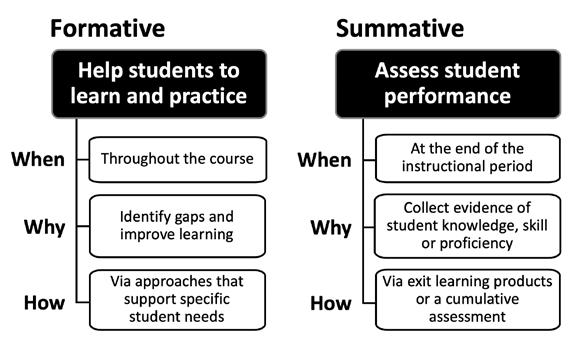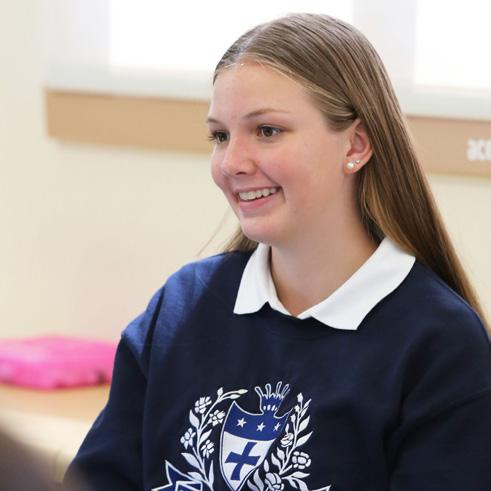
7 minute read
Handbook Addendum
The following policies and procedures will be used for the 2020-2021 academic school year and are an addendum to the Student/Parent Handbook. The structures put in place have been designed to maximize student learning throughout the year. This document will guide teaching and learning.
In-Person Learning Behavior Expectations
Advertisement
In-person learning expectations will follow the Notre Dame handbook guidelines as well as health protocols required by the county.
Remote Learning Behavior Expectations
Learning is a process that requires consistent effort, attention and time. To be successful, it is important that you stay engaged and on-task while you are in remote learning. Students are expected to: • Attend all classes that are online or in-person throughout the year. Attendance will be taken each period. • Wear appropriate free dress, per the Notre Dame dress code, or Notre Dame uniform. • Prepare for class five minutes before the start time. • Join your Zoom meeting at the beginning of the class period. If you are late, you should still join the meeting so as not to miss the entire class period. • Have all of your materials ready including books, pens, notebooks and other materials required for class.
Attendance Guidelines
Attendance is required for all classes and is mandatory during mentoring, class meetings, student body assemblies, campus ministry events and other designated required activities. Attendance will be taken each period. Students who sign-in to class or required activities late will be marked as tardy. Students who miss more than fifteen minutes of a class or required activity will be marked absent. In order to officially excuse a tardy or absence, parents must do the following: • Contact the attendance office via the 24-hour attendance line (408-294-6663) or email attendance@ndsj.org by 9:00 a.m. Provide the following information: spell the first name, last name and student’s grade level, reason for the absence or tardy, anticipated length of the absence, name and relationship of person calling. • Attendance will be monitored closely by the director of student life and the counselors. Students and parents will be contacted regarding repeated absences or tardiness.
Learning Space
Students and parents should create a physical space within the home that is conducive for learning.
Put distractions such as social media, gaming devices, or other non-academic technologies away.
Tech tools should be appropriate to the course and learning experience.
Find an appropriate space that is conducive to learning for each course. For example, you may need movement space for a class like drama, dance or physical education.
Sit upright at a workspace as if you were in class.
Have your device ready with headphones, microphone and video camera ready to use.
Handbook Addendum (continued)
Class Participation
Students' presence in class is important for building the learning community. The ability to see participants, and engage with one another, is integral to building class relationships and community. Your visual presence allows your teachers and peers to communicate with you in both verbal and nonverbal ways (facial expressions). • Keep your camera on throughout class so that you can be fully engaged in the learning activities. • Follow instructions for the use of your mic/audio as provided by the teacher. • Ensure that your screen name appears in the following format: First name Last name 'grad year (e.g. Julie Billiart '20)
Technical Issues During Class
Teachers will not be able to troubleshoot technology issues while teaching class. • If you experience technology issues during class (weak wifi connection, audio or video issues, accessing conferencing platform), please immediately use chat in Zoom or email the teacher during class so that they are aware of your challenges. • Send an email to Brooke Ahrens, director of educational innovation at bcahrens@ndsj.org for assistance. She will respond within 24 hours.
Homework
Each class will have 160 minutes of dedicated instructional time per week. This includes all college preparatory, AP and Honors courses. (Note: All school assemblies and field trips will occur on Fridays.)
Students will have 60 minutes of homework outside of structured learning time per week for each course. Students taking AP courses will have 90 minutes of homework outside of structured learing time per AP course.
Handbook Addendum (continued)
Assessment & Grading
In all learning environments, the assessment process is a relationship between a student and her teacher. Teachers are expected to provide students with regular and on-going feedback on their progress. Students are expected to read and process feedback in a timely manner to inform their own learning process.
Assessment is important in the learning process in the following ways: • Students are able to gauge their progress towards learning goals • Students are able to identify next steps in their learning • Teachers are able to gather data about students' progress and learning gaps in order to inform their instruction and to guide students towards their learning goals
Feedback Loops
A feedback loop is a process of checking for and affirming understanding that is specific, nonevaluative, manageable and focused on a learning target. It is a tool to guide and support students during the learning process to help them reach learning targets.
" ... Gone are the days of feedback scrawled below a letter grade, the days of red-inked papers and assignments."
Source: https://www.edutopia.org/blog/starting-student-feedback-loops-taylor-meredith
In order for feedback to be effective, it is important that it meet the following criteria: • goal-referenced • timely • tangible and transparent • ongoing • actionable • consistent • user-friendly
Source: Seven Keys to Effective Feedback, Grant Wiggins (ASCD, September, 2012)

Handbook Addendum (continued)
Formative & Summative Assessment of Student Learning
Current research supports a varied approach to assessment that includes both formative and summative assessments.
Source: Iowa State University: Center for Excellence in Teaching and Learning

Formative Assessment Summative Assessment
“The goal of formative assessment is to monitor student learning to provide ongoing feedback that can be used by instructors to improve their teaching and by students to improve their learning.” Carnegie Mellon University “The goal of summative assessment is to evaluate student learning at the end of an instructional unit by comparing it against some standard or benchmark.” Carnegie Mellon University
Formative assessment tasks could include the following (but are not limited to): • homework check-ins • quizzes • one-on-one conversations with students • exit ticket feedback • daily warm-ups • small group discussions • feedback from collaborative groups • peer-to-peer interaction Summative assessment tasks could include the following (but are not limited to): • presentations • essays • lab work • portfolios • tests (chapter, unit) • projects
Assessment is a tool for learning and not all assessments need to be assigned a grade. Both forms of assessment are important tools for gauging and communicating student progress.
Handbook Addendum (continued)
Grading Scale
The following grading scale will be used in all classes. Beginning with the 2020-2021 school year, pluses and minuses will no longer be part of the grading scale. If the student average is +.5, the grade will be rounded up (e.g. a grade of 79.5% will be rounded up to an B).
A B C D F 90 - 100%

80 - 89%
70 - 79%
60 - 69%
50 - 59%
Summative Assessments
The following guidelines apply to graded summative assessments.
Late Work
There is no penalty for late work. Teachers will provide students with a time for submitting late work. Late work needs to be submitted before the next summative assessment to ensure the learning cycle is complete.
Revision Policies & Sructures
As stated in Notre Dame Assessment Philosophy, revision practices should encourage students to re-learn material. Examples include: • corrections on a test • revising a written essay, project or lab report
Teachers will provide the steps and requirements for revision in their individual course syllabus.
Process/Timing of Revisions: Student revision of work should be timely and appropriate to the learning cycle in the course. Revisions are for graded summative assessments. The revisions must be arranged with the teacher and completed before the next summative assessment is given. Once this time frame has passed, revisions are no longer permitted. This is to ensure that student and teacher workload remains manageable.
Grading Student Revisions: Revised work should be assessed in the same manner as the original assessment. If a student earns an “A” on the revised work, the grade given should reflect that learning. A ceiling grade for a student who re-learns material does not reflect the student’s effort and the mastery of the material.










